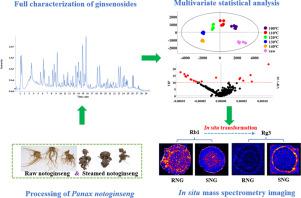Phytomedicine ( IF 7.9 ) Pub Date : 2022-06-03 , DOI: 10.1016/j.phymed.2022.154223 Wenxiang Fan 1 , Yuangui Yang 2 , Linnan Li 3 , Linhong Fan 3 , Zhengtao Wang 1 , Li Yang 1

|
Background
Panax notoginseng, a valuable medicinal plant, is traditionally used to treat trauma, body pain, and cardiovascular diseases in two clinical forms including raw (crude) and processed form. Processing-triggered compound transformation is responsible for the distinct bioactivity between raw and processed Panax notoginseng. Nevertheless, investigating the chemical diversity and dynamic transformation pattern of processed Panax notoginseng is challenging.
Methods
A new approach, which integrates multi-components characterization, processing trajectory depiction, discovery of differential markers, transformation mechanism of metabolites, in situ spatial distribution and transformation of metabolites, was established to elucidate the role of processing on the holistic chemical transformations of Panax notoginseng (PN).
Results
In this study, 136 ginsenosides (mainly rare ginsenosides) were identified or tentatively characterized and the temperature-dependent chemical variation trajectory was depicted via principal component analysis (PCA). Nineteen processing-associated markers were confirmed by orthogonal partial least squares-discriminant analysis (OPLS-DA). For the first time, the transformation pathway of ginsenosides during processing were elucidated by integrating the precursor ion scan (PIS) and mimic processing strategy that involves with deglycosylation, dehydration, hydration, acetylation, and isomerization. Results of mass spectrometry imaging (MSI) revealed the major ginsenosides M-Rb1, R1, Rg1, Rb1, Rd, and Re exhibited distinct spatial distribution pattern that are highly abundant in the xylem and showed a downward trend during processing. We firstly depicted the spatial distribution of processing-triggered rare ginsenosides (Rg3, Rk1, Rg5, etc.), and in situ transformation of ginsenosides was discovered in the process of steaming. Additionally, this variation trend was consistent with untargeted metabolomics results.
Conclusion
This study comprehensively revealed chemical diversity and dynamic transformation pattern and depicted the spatial distribution of ginsenosides of PN during processing. It could provide a clue for the distinct bioactivities between raw and processed PN and elucidate the role of processing on the holistic chemical transformations of natural products, more importantly, the proposed strategy is valuable for the quality evaluation and control of the processing of natural product.
中文翻译:

基于质谱的分析和成像策略,一种适用于揭示三七中人参皂苷在加工过程中的转化的工具
背景
三七是一种有价值的药用植物,传统上以两种临床形式用于治疗创伤、身体疼痛和心血管疾病,包括生(粗)和加工形式。加工引发的复合转化是造成生三七和加工三七之间不同生物活性的原因。然而,研究加工三七的化学多样性和动态转化模式具有挑战性。
方法
建立了一种集多组分表征、加工轨迹描绘、差异标记发现、代谢物转化机制、原位空间分布和代谢物转化为一体的新方法,以阐明加工对三七整体化学转化的作用。 (PN)。
结果
在这项研究中,136 种人参皂苷(主要是稀有人参皂苷)被鉴定或初步表征,并通过主成分分析 (PCA) 描绘了温度依赖性化学变化轨迹。通过正交偏最小二乘判别分析 (OPLS-DA) 确认了 19 个处理相关标记。首次通过整合前体离子扫描 (PIS) 和涉及去糖基化、脱水、水合、乙酰化和异构化的模拟加工策略,阐明了人参皂苷在加工过程中的转化途径。质谱成像 (MSI) 结果显示,主要人参皂苷 M-Rb1、R1、Rg1、Rb1、Rd 和 Re 表现出明显的空间分布模式,在木质部中高度丰富,并且在加工过程中呈下降趋势。等),并在蒸制过程中发现了人参皂苷的原位转化。此外,这种变化趋势与非靶向代谢组学结果一致。
结论
本研究全面揭示了人参皂苷在加工过程中的化学多样性和动态转化模式,描绘了人参皂苷的空间分布。它可以为原始和加工PN之间不同的生物活性提供线索,并阐明加工对天然产物整体化学转化的作用,更重要的是,该策略对于天然产物加工的质量评估和控制具有重要价值。



























 京公网安备 11010802027423号
京公网安备 11010802027423号